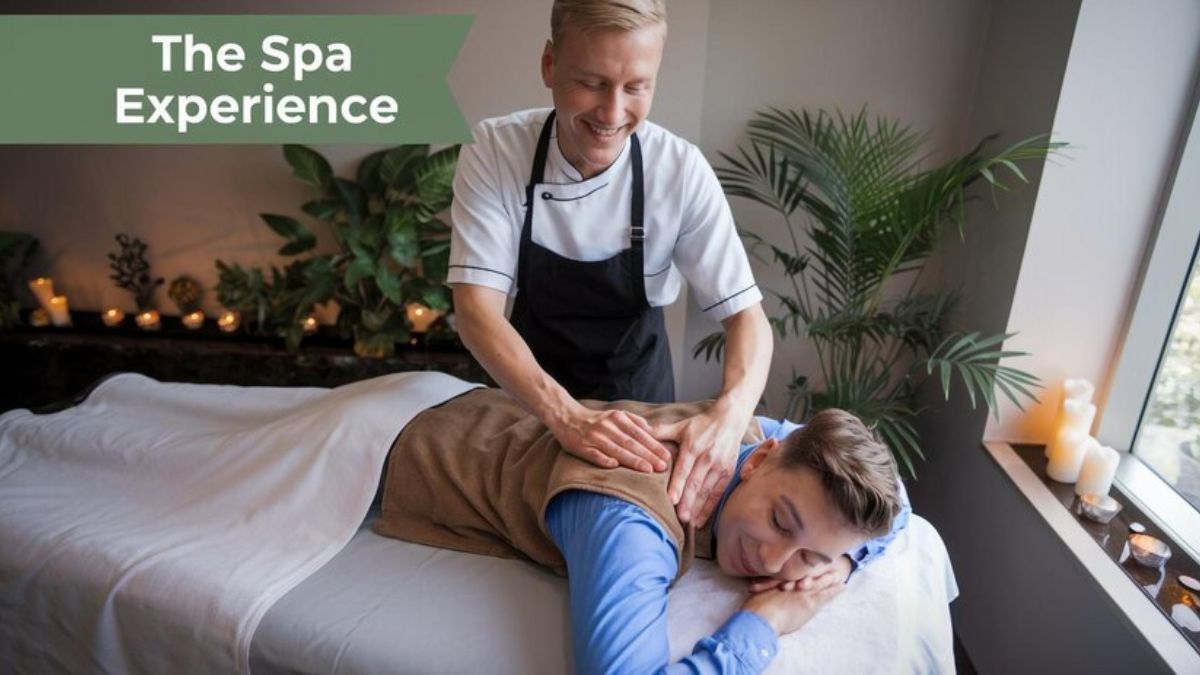FITNESS
How Massage Therapy Contributes to Overall Health and Well-being

Massage therapy has long been heralded as a critical contributor to overall wellness. Massage therapy can offer profound effects beyond mere relaxation by manipulating the muscles, ligaments, and tendons using various techniques. Understanding these benefits can elevate your wellness journey if you’re seeking a Swedish massage Bowling Green or another type. This article explores the numerous advantages of massage therapy and its ability to improve your quality of life. The advantages are numerous and scientifically backed from the physical to the emotional, making it an essential part of a comprehensive wellness routine.
Introduction to Massage Therapy
Massage therapy encompasses a variety of techniques focused on relaxing and healing the body through manipulating muscles and soft tissues. It is not only for indulgence or pampering. With its roots traced back thousands of years in ancient cultures, massage therapy has evolved, integrating traditional and modern practices to cater to various health needs.
Today, individuals turn to massage therapy for various purposes – from alleviating pain and muscle tightness to managing stress and improving overall well-being. Understanding the full scope of its advantages allows people to make educated choices about integrating this habit into their daily routines.
Physical Benefits of Massage Therapy
One of the most immediate advantages of massage therapy is its impact on physical health. Regular sessions can improve blood circulation, reduce muscle tension, and alleviate pain. Improved circulation means oxygen and nutrients are more efficiently delivered to muscle cells, accelerating recovery and promoting growth and repair. For athletes, massage therapy can be an integral part of their training and recovery regimen, helping to prevent injuries and enhance performance.
Additionally, massage therapy can be highly effective in managing chronic pain.
Mental and Emotional Well-Being
The emotional advantages of massage therapy are equally significant. Regular massage can lower symptoms of anxiety and depression. Touch therapy encourages the release of serotonin and dopamine, hormones responsible for mood regulation. It leads to better sleep, improved mood, and overall well-being. For many people, dedicating time to self-care, like getting a massage, can effectively manage stress and maintain good mental health.
Moreover, relaxation during a massage session can have lasting benefits that extend into everyday life. A calmer mind can improve focus, enhance relationships, and increase productivity. These emotional and mental benefits make massage therapy a valuable component of a balanced lifestyle, contributing to long-term mental health and emotional stability.
Types of Massage Techniques
Swedish Massage
Swedish massage is famous for its soft and calming movements. It’s excellent for relaxation and improving functional flexibility. This technique uses long, gliding strokes, kneading, and circular movements on superficial layers of muscle. It’s particularly beneficial for individuals new to massage or those looking to unwind and reduce muscle tension.
Deep Tissue Massage
Deep tissue massage targets deeper muscle layers and is ideal for chronic pain and muscle tension. In contrast to Swedish massage, it employs more pressure to access deeper muscle and tissue layers. This technique is especially helpful for athletes and individuals dealing with persistent pain and tightness.
Sports Massage
Designed for athletes, sports massage targets specific muscle groups to improve performance and speed up recovery from injuries. It includes techniques to prepare the muscles for activity, prevent injuries, and reduce muscle soreness. Sports massage can be customized to the athlete’s particular needs, whether they are preparing for a competition or recovering from one.
Aromatherapy Massage
This technique combines essential oils with traditional massage methods, enhancing physical and emotional well-being. Aromatic essential oils can provide added therapeutic benefits, such as enhanced relaxation, stress relief, and improved mood. Each essential oil used can be tailored to the client’s specific needs, providing a highly personalized massage experience.
Scientific Evidence Supporting Massage Therapy
Several studies support the manifold benefits of massage therapy. Regular massage can reduce cortisol levels, a stress hormone, by up to 31%. Reducing cortisol levels has a beneficial effect on well-being by diminishing stress and improving overall health, as elevated cortisol levels are associated with health problems like obesity, high blood pressure, and a compromised immune system.
Massage improves immune function by increasing the activity of natural killer (NK) cells. These results highlight the significance of massage therapy in supporting and improving overall health.
Ways to Add Massage Therapy to Your Wellness Regimen
Integrating massage therapy into your lifestyle can be straightforward with these steps:
- Schedule Regular Sessions: Aim to have at least one monthly professional massage session to maintain the benefits over time. Consistency is vital to experiencing the long-term advantages of massage therapy.
- Combine with Other Practices: Pair massage with activities like yoga or meditation for a holistic wellness approach. These practices complement each other, enhancing the overall sense of well-being and relaxation.
- DIY Techniques: Learn simple self-massage methods for relief between professional sessions. Techniques like a foam roller or tennis ball can help target specific muscle groups and maintain flexibility.
- Stay Hydrated: Consume ample water before and after your massage appointments to aid in the elimination of toxins and maintain proper hydration for your muscles. Adequate hydration can also improve the efficiency of the massage.
Conclusion
Massage therapy provides numerous advantages that go beyond just relaxation. Take the first step today and discover how massage therapy can be invaluable to your overall wellness journey. By understanding and embracing massage therapy’s diverse techniques and benefits, you can pave the way for a healthier, more balanced life.
FITNESS
Rowi Vitaly: The New Wave in Fitness and Wellness

Living a balanced, healthy lifestyle has never been more important. With rising awareness around physical and mental well-being, finding innovative and effective approaches to fitness has become essential for many. Enter Rowi Vitaly, a groundbreaking fitness and wellness solution redefining the way people achieve their health goals.
Combining cutting-edge technology, personalized coaching, and a holistic wellness philosophy, Rowi Vitaly is more than just a fitness program—it’s a movement that empowers individuals to unlock their full potential.
Whether you’re an athlete seeking optimal performance, a busy professional aiming to stay active, or someone on a wellness journey, Rowi Vitaly offers the tools and guidance to meet your unique needs.
What Exactly is Rowi Vitaly?
Rowi Vitaly isn’t your average fitness studio or wellness app—it’s a comprehensive system that integrates advanced methodologies with user-centric design. Think of it as the intersection of fitness, science, and technology.
At its core, Rowi Vitaly provides users with personalized health insights, curated fitness routines, and unmatched support from expert coaches. The system combines state-of-the-art fitness practices with mindfulness strategies, ensuring users cultivate not only physical strength but mental resilience as well.
With a firm belief that true wellness is multifaceted, Rowi Vitaly prioritizes customized, data-driven solutions that cater to every individual’s specific fitness and well-being goals.
Why Rowi Vitaly Stands Out
1. Personalized Fitness Plans Driven by Technology
Rowi Vitaly leverages the latest in AI-powered technology to create personalized fitness plans tailored to your goals, capabilities, and lifestyle. Forget cookie-cutter routines—Rowi Vitaly’s algorithms consider your unique fitness level, body composition, and personal preferences to craft a program that works specifically for you.
• Tracking Progress
With consistent tracking and assessments, you’ll stay on top of your improvements. Rowi Vitaly offers real-time performance feedback that keeps you motivated and ensures you’re progressing at a sustainable and effective pace.
• Smart Adjustments
Your fitness plan evolves with you. By analyzing data from wearable fitness devices and your own input, Rowi Vitaly creates agile workout modifications to prevent plateaus and keep every session fresh and engaging.
2. Holistic Wellness Approach
At Rowi Vitaly, wellness means more than working out. The program incorporates evidence-based strategies designed to enhance the mind-body connection. These include mindfulness training, stress management techniques, and nutrition guidance to achieve optimal well-being.
- Integrated Nutrition Plans
Nutrition plays a vital role in any fitness routine, and Rowi Vitaly employs seasoned nutritionists to provide customized meal plans based on your specific needs—whether you’re looking to lose weight, build muscle, or simply live healthier.
- Focus on Mental Health
With guided mindfulness exercises, meditation sessions, and stress resiliency coaching, Rowi Vitaly gives equal importance to mental fitness. The result? Stronger focus, fewer burnout episodes, and improved emotional balance.
3. Access to World-Class Coaches
The human aspect of Rowi’s Vitaly is integral to its success. Members enjoy exclusive guidance from a diverse team of skilled coaches who specialize in everything from strength training to yoga to mental health coaching.
These professionals are more than just trainers—they are mentors committed to helping you thrive. With both virtual and in-person options, Rowi’s Vitaly ensures constant connection to the support you need, every step of the way.
4. Community and Collaboration
Rowi Vitaly fosters a sense of belonging among its users by inviting members to join an inspiring community of like-minded individuals. Through in-app groups, virtual classes, and fitness challenges, you’ll never feel alone on your wellness adventure.
Sharing your progress, victories, and even occasional struggles with others enhances accountability while providing a motivational boost.
5. Exclusive Programs and Events
Rowi’s Vitaly members benefit from access to exclusive workshops, live events, and webinars featuring fitness icons and wellness experts from across the globe. These events focus on cutting-edge innovations in health and serve as opportunities for members to deepen their mind-body discipline.
Who Benefits From Rowi Vitaly?
Rowi’s Vitaly caters to a wide audience, including—but not limited to—individuals in the following categories:
- Beginners beginning their fitness or wellness journeys looking for structured guidance.
- Seasoned athletes aiming to incorporate advanced strategies and achieve peak performance.
- Working professionals juggling tight schedules who require flexibility without sacrificing results.
- Health-focused individuals who see the value in combining fitness, mental clarity, and nutritional balance.
Whether your goal is to increase endurance, lose weight, improve mental clarity, or simply prioritize your health, Rowi’s Vitaly provides a proven roadmap to success.
Steps to Get Started With Rowi Vitaly
Step 1: Schedule Your Initial Consultation
Sign up for a one-on-one onboarding session with a Rowi’s Vitaly fitness professional. They’ll assess your fitness level, lifestyle, and goals to create a program tailored to your needs.
Step 2: Download the Rowi Vitaly App
Available on desktop and mobile, the Rowi’s Vitaly app places everything you need at your fingertips—from personalized workouts to curated meal plans to mindfulness exercises.
Step 3: Engage With Your Program
Dive into workouts, connect with your coach, and track your progress. The app’s intuitive interface ensures following the plan is convenient and enjoyable.
Step 4: Connect With the Community
Join live classes, participate in challenges, and soak up the inspiration from peers dedicated to similar goals.
Step 5: Reap the Rewards
Achieve measurable, lasting results—not just in your physical health, but in your mental and emotional well-being as well.
Take Control of Your Wellness Today
The future of fitness and wellness starts with Rowi Vitaly. By blending cutting-edge technology, expert coaching, and a community-focused approach, Rowi Vitaly has redefined what it means to live a healthy, balanced lifestyle.
Why wait? Join the fitness revolution today and see the difference Rowi’s Vitaly can make. Take the first step now by scheduling your free consultation with one of our experienced wellness professionals.
Start your transformation with Rowi’s Vitaly—the new wave in fitness and wellness.
FITNESS
Rejuvenating Life: The Benefits and Considerations of Testosterone Replacement Therapy

Introduction to Testosterone Replacement Therapy
As individuals seek to maintain their energy and vitality throughout their lives, testosterone replacement therapy Washington, DC, has emerged as a compelling option. This therapy addresses the natural decline in testosterone levels experienced with age, improving overall health and fostering a sense of youthfulness. Testosterone levels are crucial for various bodily functions, so maintaining them can significantly impact an individual’s quality of life.
Recognizing the possible advantages and disadvantages of testosterone replacement therapy (TRT) is crucial for individuals contemplating this treatment. TRT is not just about replenishing hormone levels; it’s also about improving holistic quality of life. Those contemplating TRT should engage with healthcare professionals who can provide the necessary guidance and ensure that decisions are well-informed. These interactions will allow individuals to weigh the pros and cons wisely, ensuring treatment protocols are tailored to their needs and health goals.
Understanding Testosterone and Its Role in the Body
Testosterone is an essential hormone that serves multiple bodily functions and impacts physical and mental health. It is vital for muscle growth and bone density and regulates mood, sexual drive, and overall energy levels. Testosterone levels generally reach their highest point during adolescence and early adulthood. Nevertheless, after age 30, there is a gradual decrease of approximately 1% annually, considered a regular aspect of the aging process.
The Core Functions of Testosterone
- Regulating libido and sexual health: Essential for maintaining a healthy sex drive and reproductive system.
- Maintaining muscle mass and strength: Contributes to muscle building and repair, facilitating physical performance and endurance.
- Supporting mental clarity and mood stability: Hormone levels significantly affect emotions; lower levels may lead to mood swings and mental fog.
- Enhancing physical energy levels: Provides the drive for daily activities and physical exertion.
The comprehensive roles of testosterone highlight why maintaining appropriate levels is so crucial for overall well-being. Addressing these hormonal changes early can prevent potential negative impacts on health and lifestyle.
Signs and Symptoms of Low Testosterone
Awareness of the symptoms associated with low testosterone is crucial for early diagnosis and treatment. Individuals may experience a range of issues, such as persistent fatigue, mood disturbances, a noticeable decrease in sexual drive, and difficulties in muscle retention. Cognitive challenges like forgetfulness and lack of focus can also manifest.
Symptoms of this nature can cause considerable discomfort and may impede daily activities. Consequently, individuals often feel compelled to seek medical consultation. Engaging with healthcare professionals for hormone level evaluations and precise diagnosis is essential, as these symptoms can mimic those of various other health conditions. Identifying and understanding the symptoms represents the first step in improving an individual’s quality of life through suitable treatment.
The Science Behind Testosterone Replacement Therapy
Testosterone replacement therapy is designed to restore hormone levels to a more youthful balance. It utilizes methods like injections, gels, and patches. The approach is determined based on the individual’s health profile and preferred method of administration. The therapy’s objective is to reduce the symptoms linked to low testosterone by increasing physical and mental vitality, stabilizing emotional well-being, and enhancing muscle strength.
Scientific research, including studies on male hypogonadism, suggests that TRT can significantly improve life quality for those with depleted testosterone. By addressing the root cause of symptoms – hormonal imbalance, individuals often experience beneficial changes in both physical health and mental outlook.
Potential Benefits of Testosterone Replacement Therapy
- Enhanced Energy: Patients frequently indicate an enhancement in their endurance, allowing them to participate more actively in daily tasks without experiencing fatigue.
- Healthier Mood: TRT can contribute to more consistent emotional states, potentially alleviating symptoms of depression and anxiety associated with low testosterone.
- Improved Cognitive Function: Many undergoing therapy notice enhancements in focus, attention, and overall mental sharpness.
- Enhanced Sex Drive: The therapy can lead to improved sexual function and libido, significantly affecting interpersonal relationships and personal happiness.
The transformative effect of TRT can substantially alter the life experience for those burdened by the symptoms of low testosterone. Increased energy levels, stable moods, and improved cognitive and sexual health collectively contribute to a more vibrant and fulfilling lifestyle.
Risks and Considerations of TRT
Yet, as with any medical treatment, it is essential to consider potential risks associated with TRT. These can include cardiovascular issues, development of sleep apnea, and the risk of prostate enlargement. Such risks underline the necessity for a personalized treatment approach and regular monitoring from healthcare providers.
Understanding the therapy’s risks is vital; potential patients should discuss them extensively with their healthcare professionals. Personalized advice and continuous evaluation can help manage these risks effectively, ensuring that the therapy supports well-being rather than undermining it.
Making an Informed Decision
Deciding to undertake testosterone replacement therapy is a significant decision that should be made with a sufficient understanding of both personal health conditions and therapy implications. It is crucial to obtain expert medical advice to create a treatment strategy customized to individual health goals. The decision should be guided by comprehensive assessments considering potential benefits and inherent risks associated with hormone replacement therapy.
Exploring reliable sources, such as research on hormone replacement therapy, can offer additional insights into the therapy’s efficacy and long-term effects. Making informed choices leads to more favorable health outcomes and a fulfilling, energetic lifestyle.
Conclusion: The Path Forward
While testosterone replacement therapy offers a promising avenue for those seeking improved vitality, it is essential to approach it with full awareness. Every person’s health journey is unique; no one-size-fits-all solution can be applied universally. By consulting with medical professionals, understanding individual health dynamics, and judiciously considering the benefits and risks, individuals can most effectively incorporate TRT into their wellness strategies.
Ultimately, striving for balance and informed decision-making will ensure that those considering TRT can maximize its benefits, achieving enhanced well-being and a rejuvenated life.
FITNESS
The Art of Relaxation: Unveiling the Secrets of a Soothing Massage Experience

Introduction to Relaxation Through Massage
Massage therapy isn’t merely a superficial indulgence; it’s an in-depth journey into tranquility and wellness. Picture yourself unwinding in an oasis of calm, where your tension dissipates with every gentle stroke. When you visit a serene Napa spa, massages offer a magical way to rekindle your vitality.
Massages alleviate stress through the power of touch and foster a sense of renewal. They offer a means to escape the chaotic buzz of daily life, providing a sacred moment of peace. Embarking on this soothing journey, you’ll uncover how different massage techniques cater to distinct needs, delivering benefits that resonate deeply with your wellness aspirations.
Types of Massage Techniques and Their Benefits
Massage techniques vary widely, each offering unique experiences and outcomes. With their long, thoughtful strokes and gentle kneading, Swedish massages are designed to relax muscles and increase blood circulation. They are the quintessential choice for those seeking a mild stress relief session. Meanwhile, deep tissue massages delve into the deeper layers of muscle and fascia, ideal for individuals experiencing chronic tension or intense physical activity.
Hot volcanic stones are positioned on specific body spots to induce relaxation and reduce muscle stiffness, making hot stone massages a unique experience. According to a discerning study, the varied techniques can lead to differences in relaxation and physiological response, providing precise healing tailored to individual needs. Thus, understanding these techniques can guide you in selecting a massage that aligns with your health and relaxation goals.
Creating the Perfect Ambiance for Relaxation
The environment significantly influences the efficacy of a massage. A serene setting augments the relaxation process, enhancing the overall experience. Essential components such as dim lighting, peaceful music, and the gentle waft of calming scents like lavender can transform an ordinary space into a retreat for rejuvenation.
Implementing such elements, as suggested by the insightful advice from the Relaxation Institute, can substantially elevate your massage session. By fostering an atmosphere of tranquility, these ambient enhancements ensure both mind and body are primed to drift into a state of deep relaxation, allowing the healing benefits of massage therapy to unfold fully.
Exploring the Health Benefits of Massage Therapy
Massage therapy is celebrated not only for its soothing qualities but also for its substantial health benefits. It’s a delightful paradox that something so calming can also be profoundly beneficial. Regular massage sessions can improve circulation, enhancing the delivery of oxygen and nutrients to muscle cells. This can accelerate the healing process from injury and promote recovery.
Furthermore, massage therapy has been shown to reduce levels of cortisol—the stress hormone—while increasing serotonin and dopamine, neurotransmitters that contribute to feelings of well-being and happiness. Such chemical changes can significantly reduce anxiety and depression, making massages not just luxury experiences but vital components of a balanced approach to mental health and emotional well-being.
Tips for a Relaxing At-Home Massage Experience
The comforts of home don’t have to exclude the luxuries of a spa-like massage experience. You can recreate this calming ritual carefully in your own space. Begin by selecting a quiet area free from interruptions, ensuring a clutter-free, tranquil environment that encourages relaxation.
Use aromatic oils like chamomile or eucalyptus to enhance the sensory experience and add additional health benefits, such as reducing pain and inflammation. Learn some basic massage techniques or enlist the help of a partner, focusing on slow, gentle movements that replicate the soothing rhythm of professional massages, allowing tension to release and serenity to wash over you.
Next Steps: How to Incorporate Regular Massage into Your Life
Integrating regular massage therapy into your lifestyle is a commitment to ongoing wellness. Begin by scheduling routine sessions into your calendar, treating them as essential appointments for your health, not just optional indulgences. Consider the range of techniques available to find those that best address your particular needs, whether they involve stress management, injury recovery, or enhancing flexibility.
Consistency is crucial to reaping the full spectrum of benefits massages offer. By making these sessions a regular aspect of your lifestyle, you’re investing in long-term physical health, emotional balance, and an improved quality of life beyond the massage table.
Conclusion: The Long-Term Benefits of Embracing Relaxation
Embracing massage therapy as a cornerstone of your relaxation routine yields many benefits that extend into every aspect of life. Over time, the balance and harmony introduced by regular massages lead to lasting improvements in physical vitality and mental clarity, offering a transformative retreat from modern life’s hustle and bustle.
By prioritizing relaxation, you forge a more profound connection with yourself, cultivating peace and awareness that provides a haven amidst life’s chaos. Allow massages to be your ally in this journey towards a perpetually serene state of being.
-

 HEALTH1 year ago
HEALTH1 year agoIntegrating Semaglutide into Your Weight Loss Plan: A Practical Guide
-

 HOME IMPROVEMENT1 year ago
HOME IMPROVEMENT1 year agoHow to Choose the Perfect Neutral Area Rug for Every Room
-

 LAW1 year ago
LAW1 year agoTeenage Drivers and Car Accidents in California: Risks and Parental Liability
-

 LAW1 year ago
LAW1 year agoPost-Divorce Considerations in California: Modifications and Long-Term Planning
-

 CONSTRUCTION1 year ago
CONSTRUCTION1 year agoConstruction Site Safety Regulations in New York and Your Rights as a Worker
-

 HOME1 year ago
HOME1 year agoSandra Orlow: The Teen Model Who Captivated the Internet
-

 FINANCE1 year ago
FINANCE1 year agoDigital Asset Management in Florida Estate Planning
-

 LAW1 year ago
LAW1 year agoKentucky’s School Football: Concussions, Injuries, and Legal Options
